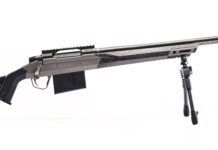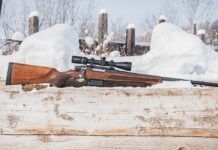A few years ago, the incidence of factory-supplied threaded barrels on rifles was negligible, because most people didn’t have a lot of interest in changing their muzzle devices, including flash suppressors and sound suppressors. Sound suppressors, also incorrectly known as silencers, and more accurately called “mufflers” or “moderators,” just weren’t that common because the devices were regulated by the National Firearms Act (NFA) of 1934. In that law, Congress used its tax power to set up a tax-and-registration system for machine guns, short-barreled shotguns and rifles, grenades, mortars and various other devices, including sound suppressors.
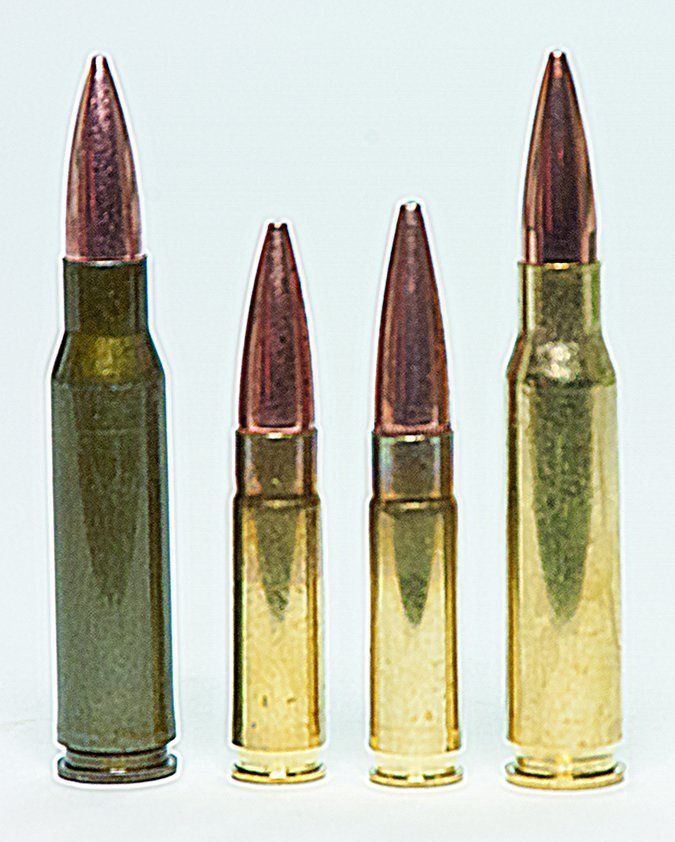
Under the NFA today, a prospective owner must go through a months-long registration process with the Bureau of Alcohol, Tobacco, Firearms and Explosives (BATFE) and pay a $200 tax, in advance, before he or she can purchase a suppressor. Despite the difficulties posed by the regulatory system, suppressor sales have continued to grow over the last decade, and especially the last five years. Suppressor ownership is legal in most states. The exceptions are Hawaii, California, Illinois, New York, New Jersey, Delaware, Rhode Island, and Massachusetts. In the 42 states where suppressors are legal, they are allowed for hunting in all but Connecticut and Vermont, and states are de-regulating suppressor use every day, so this list may be outdated by the time you read this.
Concurrent with the sales growth of suppressors, manufacturers have responded by making the muzzles of some of their rifles and pistols easier to receive the devices. Thus, the growth of factory-threaded barrels, three models of which we recently tested, with and without a suppressor.
The Contestants
We wanted to test three threaded-muzzle bolt actions in a reference chambering well known to hunters and shooters, the 308 Winchester, along with a less-common bolt-action choice, the 300 AAC Blackout, which is more often chambered in AR-15 uppers because it has the same overall length, base diameter, and rim diameter as the 5.56 NATO round, so it will feed from an unmodified magwell in an AR-15 lower. The 300 Blackout can be loaded with lighter bullets, where it compares favorably to the 7.6239mm Soviet round, or loaded with heavier bullets that travel below subsonic speeds for suppressor use. At sea level, the speed of sound is roughly 1125 fps, with the “roughly” changing based on air temperature and other conditions. Subsonic ammo is easier to suppress at the muzzle, and it doesn’t create the downrange “crack” as the bullet breaks the sound barrier.

Our first test rifle was a Savage 10PT-SR No. 22356 chambered in 308 Winchester, $550 at an Academy Sports and Outdoors retail store in Houston. The bolt-action rifle featured a 5⁄8×24-threaded barrel with a thread protector and a matte-blued finish, a synthetic stock with a beavertail forend, a BA-style bolt handle, and a black one-piece 1913-cut aluminum-alloy accessory rail. It featured the company’s AccuTrigger and Accustock and came with one detachable-box magazine, which had a steel body and polymer floor and release tab. The knurled-steel thread protector came installed on the 18-inch-long barrel. The protector detached from the muzzle with a twist of the hand, and went back on easily.
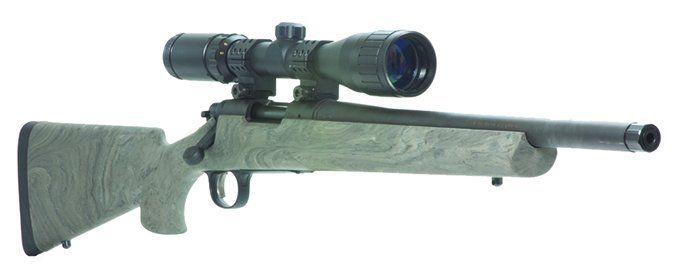
The first 300 Blackout rifle was the Remington Model 700 Special Purpose Synthetic (SPS-T, No. 84205), announced in 2012. The 300 Blackout is one of three SPS-T models with 16.5-inch-long barrels, with one (No. 85549) chambered in 223 Remington and the third in 308 Win. (No. 85538). Capacities of the 223 and the 300 are five in an internal magazine, and four for the 308 Win. Two other models in the line, a 223 Rem. and a 308 Win., have 20-inch barrels, the Nos. 84206 and 84207, respectively. It lists for $817 MSRP, but we bought ours at Academy for $680. The Model 700 SPS-Tactical has a cylindrical Model 700 receiver machined from solid steel, with a heavy-contour barrel and muzzle cut to accept 5⁄8×24 threaded flash hiders, muzzle brakes, and suppressors. The short carbon-steel hammer-forged barrel handles well in tight spots, we found, and with most ammunition, it delivered pinpoint accuracy. With a twist rate of one in seven inches, this rifle should stabilize heavier bullets well, but in our testing, it didn’t, at least unsuppressed.

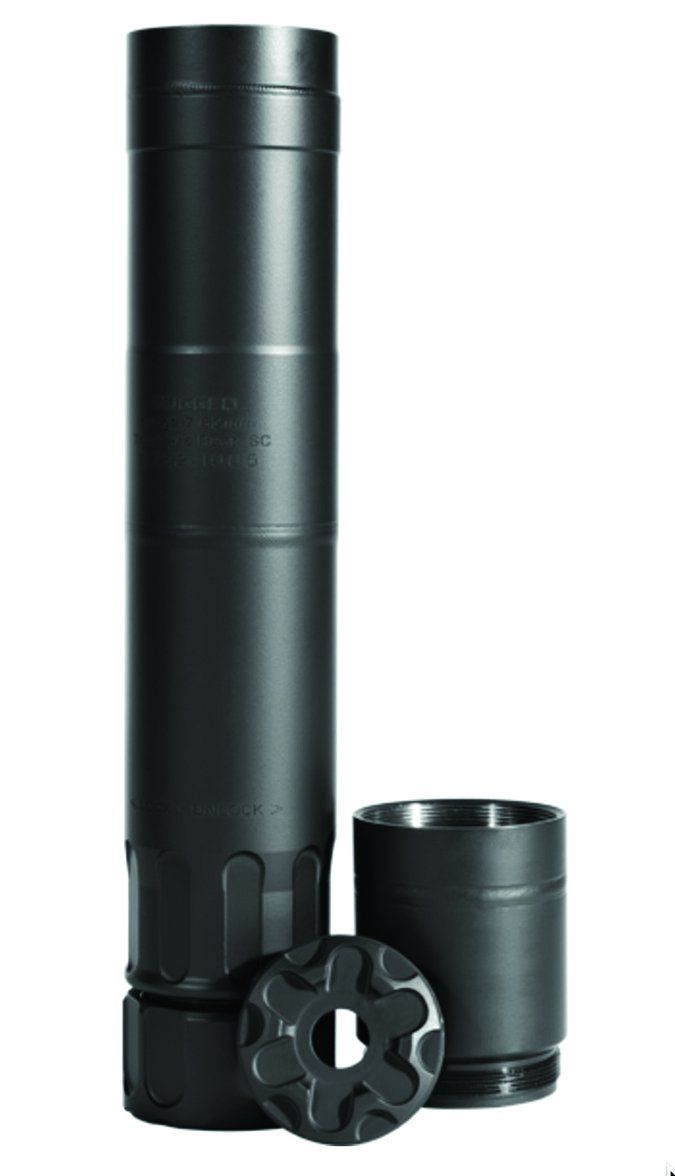
The runt of the trio — in terms of size, weight, and cost — was the Ruger American Rifle Ranch No. 06968 in 300 AAC. We bought it at Academy on sale for $420, well under its suggested retail of $529. The Flat Dark Earth (aka tan) lightweight synthetic stock featured modern forend contouring and grip serrations. It didn’t come with sights, like the others, but instead had a non-Picatinny scope rail installed. By this we mean a one-piece M-223 Nikon 1913 scope base wouldn’t fit the groove pattern on the rail as it did on the Savage, whose one-piece rail was 1913-spec and took the Nikon base willingly. This annoyance required re-ringing our Nikon test scope with two Weaver tactical bases to switch the optic between guns, but this still put the Ruger a step ahead of the Remington rifle, which didn’t come with any bases. We used Weaver #35/36 bases for the SPS-Tactical. Elsewhere, the Ruger had a short, very handy 16.12-inch-long barrel with 1:7 right-hand twist. The Ruger Marksman adjustable trigger allows the pull weight to be adjusted down to 3 pounds, so that’s where we set it. The Power Bedding integral bedding block system in the stock was supposed to free-float the barrel, but our sample had some interference in the stock channel, which we could have removed with a Dremel, but we chose not to because that’s how the rifle came out of the box. If the stock hurt accuracy, then that would be penalty enough, we decided. Of course, the muzzle also had the 5⁄8×24 thread pattern like the others.
How We Tested
To collect chronograph and accuracy data, we set up at American Shooting Centers in Houston (AMShootCenters.com). We recorded velocities using an Oehler Model 35 Proof Chronograph ($595 from Oehler-Research.com) with the first screen set 10 feet from the muzzle. Velocities were recorded with an air temperature of 82 degrees and 90% humidity, with 20-mph 6 o’clock winds. For bench-accuracy shooting at 100 yards, we fired the rifles off Caldwell DeadShot shooting bags. Accuracy is the average group size for 10 three-shot groups, measured center-to-center of the widest-apart bullet holes in each group, then rounded to the nearest tenth of an inch. Suppressed data was collected with a Rugged Suppressors Surge 7.62 ($992 from SilencerShop.com).
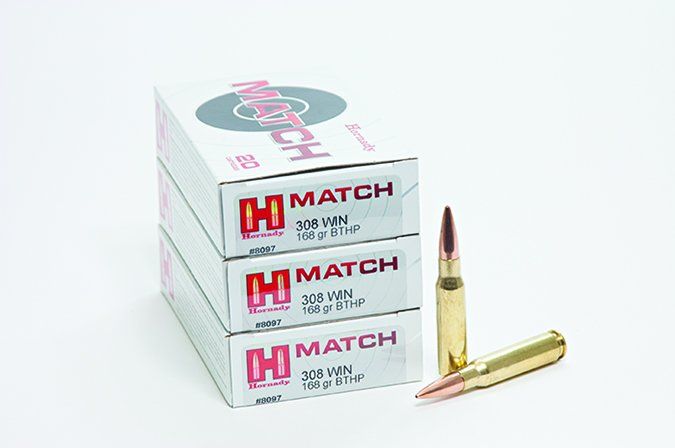
The riflescope was a Nikon M-223 series 3-12x42mm No. 16305, whose BDC (bullet-drop compensating) system has the lower half of the vertical reticle wire showing a series of open circles and hash marks that can quickly be put over a target. Though the scope circles are set up for an optimum 55-grain 223 Rem. loading, Nikon’s Spot On Ballistics Match Technology iPhone app allows shooters to obtain instant data specific to their shooting equipment. The shooter simply enters his BDC-equipped Nikon model, load data, and preferred zero range, and the program will show the precise range for the crosshairs and each ballistic circle. While at the range we used an iPhone 7 Plus to consult Spot On and move from a 100-yard zero and shoot center shots at 300 yards with no come-up adjustment. For example, with the 308 Win. in the Savage using the 168-grain Hornady load, the second hash mark from the top offered a 294-yard point of impact.
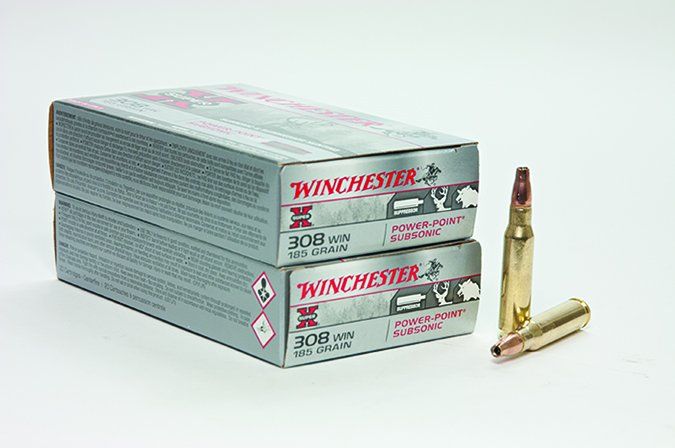
Elsewhere, the scope is equipped with a side-focus turret for parallax correction and a one-piece 1-inch main tube that is nitrogen-filled and O-ring-sealed. The glass lens elements are fully multi-coated and offer sharp target images. Adjustment clicks gave the expected quarter-inch of bullet impact at 100 yards, and we could adjust the click-stops while keeping the head on the stock because the adjustments have tactile clicks. Eye relief was 3.9 inches. It runs $460 at OpticsPlanet.com.
We mounted the scope to the rifles with Weaver’s Six Hole Tactical Rings, which have six Torx screws per ring for extra security. We started with the Savage, which had a Picatinny top rail already affixed, then adjusted the rear ring to fit the cross slots on the non-Pic Ruger base and the Weaver bases on the Remington without having to re-level the scope.
The Suppressor
In early 2007, BATFE said there were about 1.3 million silencers registered in the United States, an increase of nearly 400,000 registered silencers since the same time in 2016, when ATF records indicated there were 902,805 silencers in the country.
Why do people own suppressors? There are two common reasons: reducing noise pollution and protecting hearing. If you hunt in state or national forests or other locations near where people live, suppressors can keep gunfire sounds from annoying nearby residents. On a personal basis, many of our test shooters have hearing damage caused by gunfire. We now use plugs and earmuffs to reduce the felt decibel level of gunfire, but had suppressors been more widely available back in the day, perhaps we could hear our spouses better today. We think the trending numbers of suppressor ownership reflect the advantages the devices give shooters.
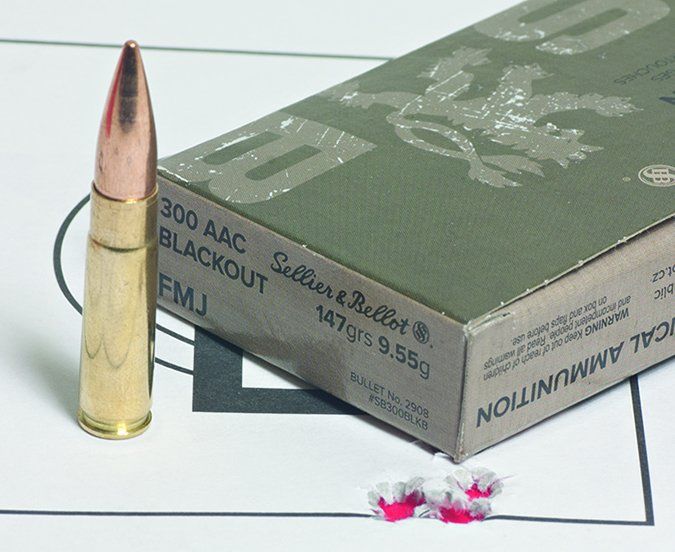
As noted above, we also shot all the rounds for velocity and accuracy with a Rugged Suppressors Surge 7.62 from SilencerShop.com in Austin, Texas. The Surge 7.62 is a modular 30-caliber rifle silencer, which enables the shooter to change the size and configuration of the silencer. It has a removable section of the tube that allows the shooter to go from a full-size 9-inch silencer to a shorter 7.5-inch unit. Also, by adding an interchangeable 5.56 endcap or 7.62 endcap and respective muzzle devices for both calibers, the Surge 7.62 can be assembled as a 9-inch or 7.5-inch 30-caliber silencer rated up to 300 Remington Ultra Mag or as a 9-inch or 7.5-inch 5.56 silencer. According to Silencer Shop sound-pressure measurements, it produces a sound reduction level down to 134 to 138.4 dB. Depending on configuration, it weighs 17.5 ounces to 21.5 ounces and is made of a 17-4 stainless steel called Stellite with a high-temp Cerakote finish. It comes with a spanner tool to remove the endcap and a user manual. Installation was simple: With the bolt out of the action, tilt the rifle muzzle upward and start the Surge onto the provided threads. (We think taking the bolt out of the action is a prudent safety step because at least one hand is too near the muzzle to futz around otherwise.) Screw the main barrel of the Surge down as far as it will go on the muzzle threads and tighten the locking collar.
We shot the Surge in only the 9-inch mode and was impressed with the 300 BLK suppression. When paired with 220-grain subsonic rounds, the report is barely noticeable with plugs and muffs on (there were other shooters who weren’t shooting suppressed). According to Silencer Shop’s testing, the 9-inch configuration creates 122 dB with subsonic 300 BLK while the 7.5-inch format comes in at 128 dB. At similar speeds, we’d expect the 220-grain 308 Win. to perform the same.
Test Ammunition & Results
Our test ammunition included both supersonic and subsonic rounds. For the 308 Win. Savage, we chose Hornady Match 168-grain Boattail Hollowpoint 8097, Monarch 145-grain Full Metal Jackets, and Winchester Super-X 308 Winchester 185-grain Power-Point JHP Subsonic X308SUBX. The 300 AAC Blackout rounds were Remington UMC 300 AAC 120-grain OTFB Supersonic L300AAC1, Remington UMC 300 AAC 220-grain Open-Tip Flat Base (OTFB) Subsonic 21422, and Sellier & Bellot 300 AAC 147-grain Full Metal Jacket SB300BLKB.
Range Data: .308 Winchester
Ammunition sources: Hornady Match 308 Winchester 168-gr. Boattail Hollowpoint 8097 ($29/20 from Academy Sports & Outdoors); Monarch 308 Winchester 145-gr. Full Metal Jacket ($10/20 from Academy Sports & Outdoors); and Winchester Super-X 308 Winchester 185-gr. Power-Point JHP Subsonic X308SUBX ($24.50/20 from MidwayUSA.com).
| Savage 10PT-SR | ||
| Hornady Match 308 Win. 168-gr. BTHP 8097 | Unsuppressed | Suppressed |
| Average velocity | 2596 fps | 2618 fps |
| Muzzle energy | 2513 ft.-lbs. | 2556 ft.-lbs. |
| Average group | 1.2 in. | 0.8 in. |
| Monarch 308 Win. 145-gr. FMJ |
||
| Average velocity | 2685 fps | 2668 fps |
| Muzzle energy | 2320 ft.-lbs. | 2291 ft.-lbs. |
| Average group | 1.2 in. | 1.2 in. |
| Winchester 308 Win. 185-gr. Hollowpoint | ||
| Average velocity | 1109 fps | 1079 fps |
| Muzzle energy | 505 ft.-lbs. | 478 ft.-lbs. |
| Average group | 1.4 in. | 1.2 in. |
| To collect chronograph and accuracy data for all three rifles, we set up at American Shooting Centers in Houston (AMShootCenters.com). We recorded velocities using an Oehler Model 35 Proof Chronograph ($595 from Oehler-Research.com) with the first screen set 10 feet from the muzzle. Velocities were recorded with an air temperature of 82 degrees and 90% humidity. For bench-accuracy shooting at 100 yards, we fired the rifles off Caldwell DeadShot shooting bags. Accuracy is the average group size for 10 three-shot groups, measured center-to-center of the widest-apart bullet holes in each group, then rounded to the nearest tenth of an inch. Suppressed data was collected with a Rugged Suppressors Surge 7.62 ($992 from SilencerShop.com). | ||
| Ammunition sources: Hornady Match 308 Winchester 168-gr. Boattail Hollowpoint 8097 ($29/20 from Academy Sports & Outdoors); Monarch 308 Winchester 145-gr. Full Metal Jacket ($10/20 from Academy Sports & Outdoors); and Winchester Super-X 308 Winchester 185-gr. Power-Point JHP Subsonic X308SUBX ($24.50/20 from MidwayUSA.com). | ||
Range Data: 300 AAC
| Remington M700 SPS-T | Ruger American Ranch | |||
| Remington UMC 300 AAC 120-gr. OTFB L300AAC1 | Unsuppressed | Suppressed | Unsuppressed | Suppressed |
| Average velocity | 2222 fps | 2236 fps | 2210 fps | 2229 fps |
| Muzzle energy | 1315 ft.-lbs. | 1332 ft.-lbs. | 1301 ft.-lbs. | 1323 ft.-lbs. |
| Average group | 1.4 in. | 1.2 in. | 1.4 in. | 1.2 in. |
| Sellier & Bellot 300 AAC 147-gr. FMJ SB300BLKB | ||||
| Average velocity | 2099 fps | 2110 fps | 2064 fps | 2096 fps |
| Muzzle energy | 1438 ft.-lbs. | 1453 ft.-lbs. | 1390 ft.-lbs. | 1434 ft.-lbs. |
| Average group | 1 in. | 0.4 in. | 1 in. | 0.8 in. |
| Remington UMC 300 AAC 220-gr. Subsonic 21422 | ||||
| Average velocity | 1075 fps | 1088 fps | 1073 fps | 1089 fps |
| Muzzle energy | 564 ft.-lbs. | 578 ft.-lbs. | 562 ft.-lbs. | 579 ft.-lbs. |
| Average group | 6 in. | 0.6 in. | 1.8 in. | 0.8 in. |
| Ammunition sources: Remington UMC 300 AAC 120-grain OTFB Supersonic L300AAC1 ($16/20 from Academy Sports & Outdoors); Remington UMC 300 AAC 220-grain Open-Tip Flat Base (OTFB) Subsonic 21422 ($17/20 from Academy Sports & Outdoors); and Sellier & Bellot 300 AAC 147-grain Full Metal Jacket SB300BLKB ($13/20 from MidwayUSA.com). | ||||
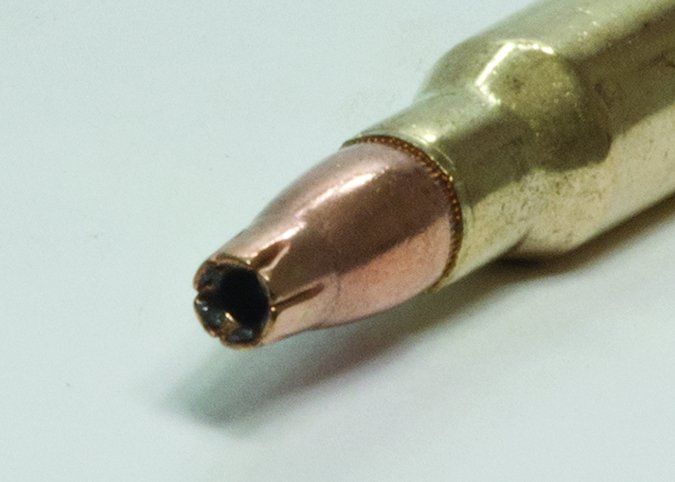
As shown in the nearby Range Data tables, the Savage shot consistently at 1-minute-of-angle with the Hornady Match 308 Win. 168-gr. boattail hollowpoints. Average group sizes were 1.2 inches unsuppressed and 0.8 inches suppressed. Average velocity unsuppressed was 2596 fps and 2618 fps suppressed. The Monarch 308 Win. 145-grain FMJ shot 1.2-inch average groups both unsuppressed and suppressed and had respective average velocity of 2685 fps and 2668 fps unsuppressed and suppressed. The subsonic Winchester 308 Win. Super-X 185-grain hollowpoint didn’t shoot as well unsuppressed (1.4 inches) as it did suppressed (1.2 inches). Average velocity was 1109 fps unsuppressed and 1079 fps suppressed.

The results for the 300 AAC in the Remington and Ruger rifles were substantially better with one of the rounds. Shooting the Remington 120-grain load, the SPS-T fired 1.4-inch unsuppressed average groups and 1.2-inch suppressed average groups, results mirrored by the Ruger with the same ammo. Average velocities were 2222 fps unsuppressed and 2236 fps suppressed in the SPS-T and 2210 fps unsuppressed and 2229 fps suppressed in the Ruger. Things improved markedly for both rifles shooting the Sellier & Bellot 300 AAC 147-grain FMJs. Both rifles shot this round into 1.0-inch groups unsuppressed and 0.8-inch average groups for the Ruger and a best-of-test 0.4-inch average group size in the Remington.
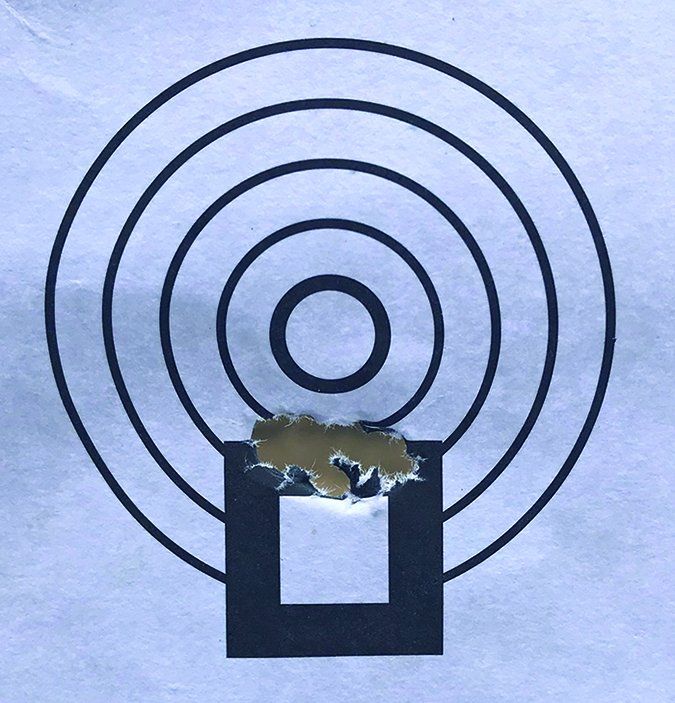
Average velocities in the Remington were higher suppressed, 2110 fps to 2099 fps unsuppressed, and in the Ruger 2096 fps suppressed and 2064 fps unsuppressed. Shooting unsuppressed, neither rifle liked the 220-grain subsonic round from Remington, with the SPS-T shooting patterns, instead of groups, that averaged 6.0 inches and the Ruger shooting 1.8-inch average groups. Suppressed was another matter altogether, with the Remington firing the namesake 220-grain round into 0.6-inch average groups and the Ruger also shooting well with 0.8- inch groups. Average velocities were all safely below supersonic, with the SPS-T shooting 1075 fps and 1088 fps unsuppressed and suppressed, respectively, and the Ruger producing 1073 fps and 1089 fps unsuppressed and suppressed, respectively.
Here are more detailed notes about how each rifle performed.
Savage Arms 10PT-SR 22356 308 Winchester, $550
GUN TESTS GRADE: B+
Good build. It wasn’t the most accurate, and we didn’t like the feel of the magazine fit and lock. But it did shoot sub-MOA with one round. We loved the bolt handle and the AccuTrigger.

| ACTION | Bolt; steel cylindrical receiver |
| OVERALL LENGTH | 38.25 in. |
| HEIGHT UNBOXED | 7.25 in. |
| HEIGHT AS TESTED | 8.6 in. |
| MAX WIDTH | 3.1 in. |
| WEIGHT UNBOXED | 7.7 lbs. |
| WEIGHT RANGE | 9.6 lbs. |
| BARREL LENGTH/TWIST | 18 in.; 1:10 RH |
| BARREL FINISH/MATERIAL | Matte-blue carbon steel |
| BARREL FLOATED | Yes |
| BARREL MUZZLE DIAMETER | 0.843 in. |
| BARREL MUZZLE STYLE/DEVICE | 5/8″ -24 thread; knurled steel thread protector |
| STOCK | AccuStock black synthetic; checkered pistol grip |
| STOCK LENGTH OF PULL | 13.75 in. |
| STOCK COMB STYLE | Straight |
| STOCK DROP AT COMB | 1.75 in. |
| STOCK DROP AT HEEL | 2.25 in. |
| STOCK PITCH | 3.25 in. |
| STOCK CAST | None |
| STOCK HANDEDNESS | Ambidextrous |
| STOCK FOREND STYLE | Beavertail |
| STOCK BUTTPAD THICKNESS | 1.1 in. |
| STOCK SLING SWIVEL ATTACHMENTS | 1 butt, 2 forend |
| STOCK GRIP CAP | Black plastic |
| TRIGGER PULL WEIGHT | 2.5 lbs.; AccuTrigger; adjustable |
| TRIGGER STYLE | Single stage |
| TRIGGER GUARD MATERIAL | Black aluminum alloy |
| SAFETY | 2-position tang-mounted slider button |
| MAGAZINE | (1) 4-rd. detachable box; stamped steel and polymer |
| MAGAZINE RELEASE | Grooved polymer tab; front of magazine |
| BOLT | 2 lug; blued steel plunger ejector; 90-degree throw, BA bolt handle; floating bolt head |
| BOLT RELEASE | Trigger-guard button and trigger-pull combo |
| SIGHTS | None |
| OPTICS MOUNTING HARDWARE | Picatinny rail installed; aluminum |
| WARRANTY | 1-year limited |
| TELEPHONE | (800) 370-0708 |
| WEBSITE | SavageArms.com |
| MADE IN | Westfield, MA |
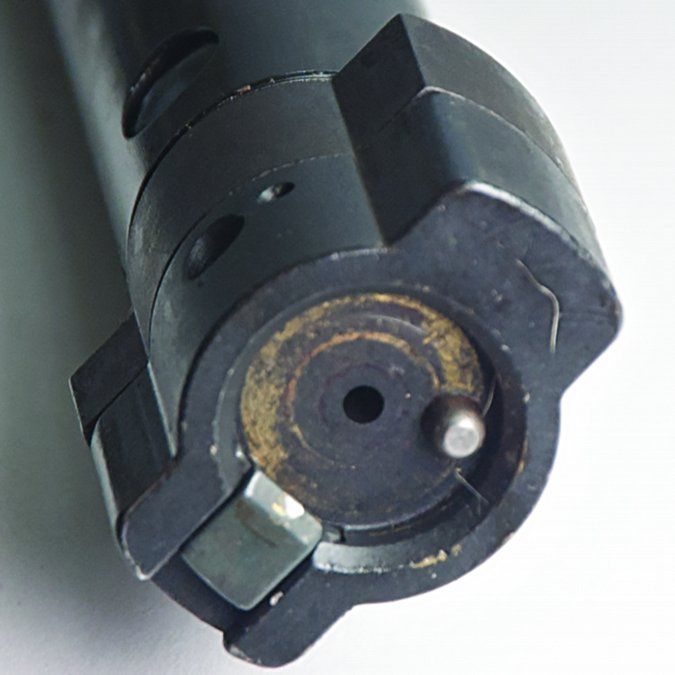
This was the counter price at an Academy Sports and Outdoors store in Houston, and we couldn’t find this model number for sale anywhere else. In the box came the rifle with a mounted 1913-cut accessory rail, a lock, and manual. The manual was for the Model 10/110 LE Series and Model 12/112 Target/Varmint series.
As we noted above, both the Remington and Ruger rifles outshot the Savage across the board, but the results from the Savage weren’t bad at all, slightly above minute-of-angle for most loads, and better than MOA with the Hornady Match 308 Win. 168-grain boattail hollowpoints.
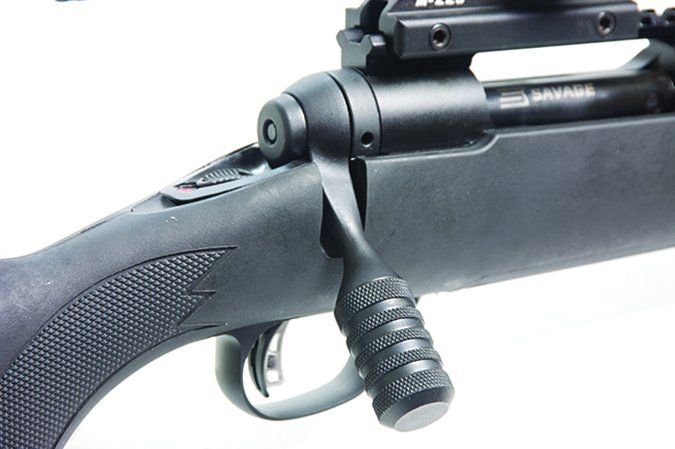
All in, this is a big rifle, despite its short barrel length. The thick diameter at the muzzle (0.843 inch) suggests how heavy the barrel contour is, and the unboxed weight is 7.7 pounds — lighter to be sure than the Remington at 8.25 pounds dry weight, but a pound and a half more than the Ranch rifle. Surprisingly, that’s not very heavy muzzle biased, with the balance point of the rifle without a scope occurring at the front of the magwell. But when you add the Surge can, all get very front heavy. With a scope and a full complement of ammo, its range weight ticked in at 9.6 pounds. So if you were going to use the Savage as a deer or varmint rifle, its short overall length (38.25 inches) would be handy in a blind, but we’d prefer the Ruger for walking.
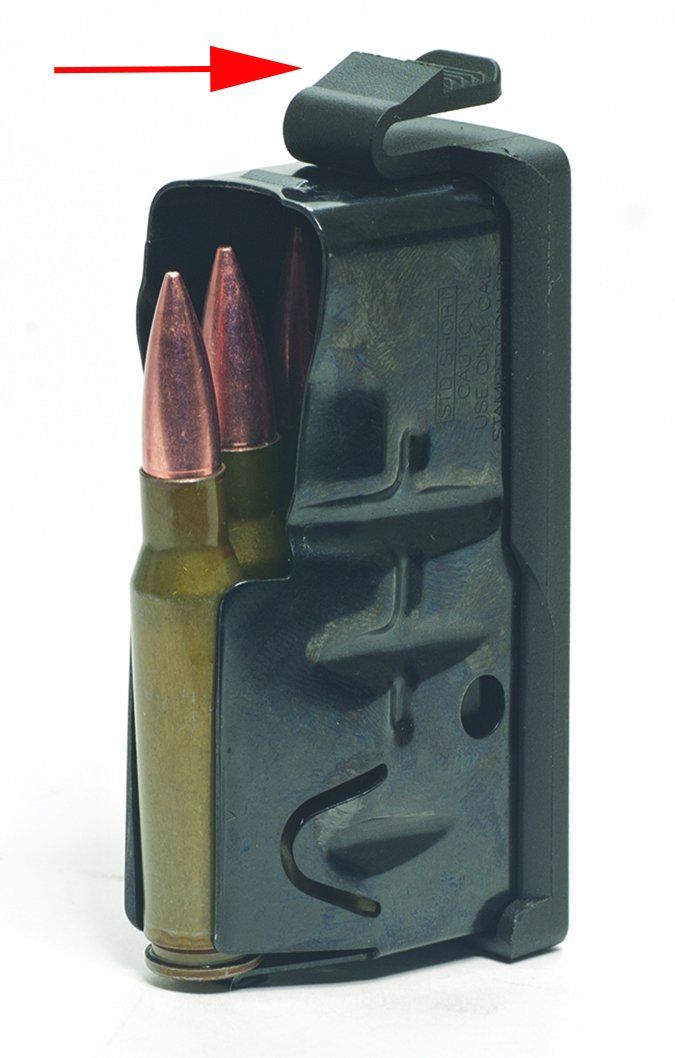
The bolt-action rifle had a black synthetic stock with a beavertail forend, which rested on the bags firmly. The straight comb was comfortable, and the 13.75-inch length of pull didn’t bother our shooters. There were two sling-swivel studs in the forend, one more than the other rifles, which would likely be used to attach a bipod and sling. We noted the shape of the stock mildly favored the right-handed shooter. The AccuStock incorporates a bedding system with two action screws. When tightened, the action is pulled inside an integrated aluminum bedding cradle that is slightly narrower than the receiver. To eliminate forward and rearward motion during recoil, the bedding cradle uses a rearward-sloping cutout for the recoil lug. The barrel free-floats in the barrel channel. At the range, we noticed the pitch of the stock caused the shooter to ride higher on the butt than on the other rifles, and with heavier-recoiling ammunition, that caused more upward pressure to be transmitted to the face during recoil. Also, we noticed a mold line up and down the stock, which we would have liked to dress down. The line was fairly prominent on the pistol grip, and it abraded the shooting hand more than the others.
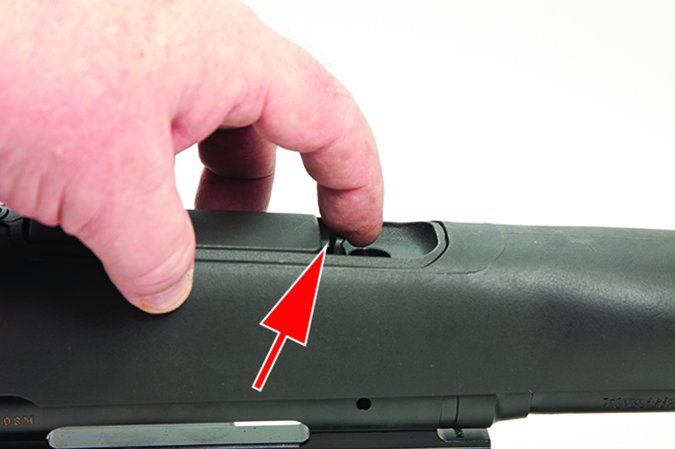
All three rifles had adjustable triggers. To adjust the AccuTrigger, make sure the firearm is unloaded and the bolt is open before removing the stock and adjusting the trigger. Remove the stock and insert the AccuTrigger supplied tool into the bottom of the trigger return spring to engage the spring-tail with the slot on the tool. Turn the trigger return spring with the trigger adjustment tool. To adjust for a heavier pull, turn the tool clockwise. The maximum trigger pull is at the point where the spring clicks when rotated. We went the other way, turning the tool counter-clockwise to get a minimum trigger pull. This occurs when the large coil contacts the top surface of the trigger and we felt resistance. We were happy with the pull at 2.5 pounds, and we dropped the rifle on its butt and sides to ensure that the sear didn’t release with the safety in the Fire position. That pull weight was on par with the Remington and slightly better than the Ruger at 3.0 pounds.
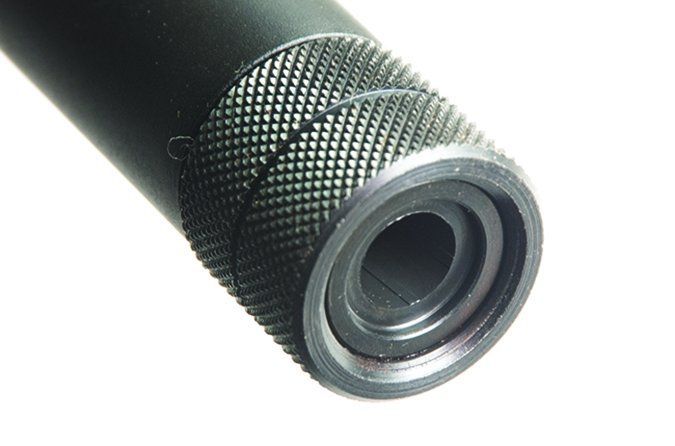
Operationally, the Savage was very well mannered. Installing a riflescope was easy because it came fitted with a 1913 rail, a plus over the non-Pic rail on the Ruger and a double plus over the Remington, which required fitting bases on the drilled-and-tapped action. We had no issues installing or removing the Rugged suppressor on the 5⁄8×24 threaded barrel. The thread protector was easy to remove and install. We liked the big BA-style bolt handle better than the others because it provided a lot of leverage opening and closing the action. We had some misfeeds out of the supplied magazine, which was hard to seat. On a few occasions, a 220-grain round would be picked up out of the magazine but the tip wouldn’t elevate enough to enter the chamber cleanly, and the bolt would stop behind the jammed cartridge. We’d have to back the bolt out then use a pair of forceps to pry the round loose, then run the bolt behind the cartridge again while pressing down the others in the magazine. We otherwise had no failures to fire or extract, and brass exited a couple of feet to the right on ejection. We favored the cushy buttpad on the Savage; it was thick and soft and made shooting the 308s pretty comfortable.
The safety on the Model 10/110 has three positions. The Safe position has the safety button fully rearward toward the shooter and the red dot on the tang covered. This blocks the trigger and prevents the bolt from being opened. The Mid Position has the trigger blocked and allows the bolt to be opened. The Fire position has the safety button pushed away from shooter, exposing the red dot on the tang. Everything worked perfectly in this system.
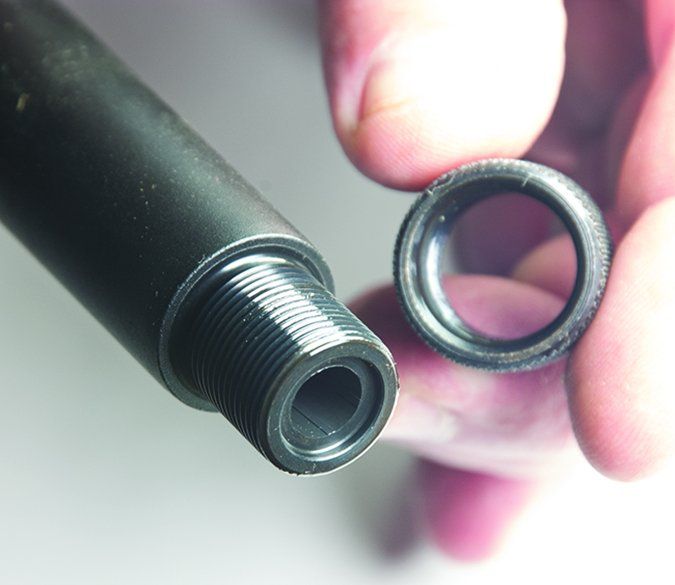
From the kneeling and standing positions, we could run the 90-degree bolt throw comfortably without having to take our cheeks off the stock. The big bolt handle aided this process as well. Prior to installing the bolt, the shooter first ensures the bolt assembly matches the action by verifying that the four digits engraved on the bolt extractor match the last four digits of the serial number on the receiver. Ours did. Then, with no ammunition in the chamber and the magazine out of the gun, we rotated the front baffle to line-up the bolt guide with the extractor, pulled the trigger fully rearward and held it in that position, then inserted the bolt into the firearm, pushing it forward. To remove the bolt, which we did a lot to ensure the gun couldn’t be fired when we installed the suppressor, with an empty gun and the muzzle pointed in a safe direction, we moved the safety forward to Fire, lifted the bolt handle and pulled the bolt fully to the rear, opening the action, then pulled the trigger fully rearward and held it in that position. Then we pushed the bolt release on the front of the trigger guard as far as it would go into the trigger guard and grabbed the bolt handle, pulling the bolt assembly fully rearward until it cleared the receiver. We noted a couple of occasions when the bolt seemed to bind or stop, which usually meant we had lost engagement on either the trigger or bolt release, or that the bolt release was not pushed as far as it would go into the trigger guard. Savage noted the presence of a cocking indicator on the back end of the bolt, the purpose of which is to visually show when the firearm is cocked. This is not a loaded-chamber indicator. Supposedly, when cocked, the tip of the indicator protrudes from the rear of the bolt. When uncocked, the tip of the indicator recesses inside the bolt body. Our indicator did do this, but it was so subtle we couldn’t tell visually if the bolt was cocked or not. We could feel the back of the bolt to learn that the cocking indicator was flat against the bolt housing (cocked), or that it was barely indented (uncocked).
Our Team Said: We dinged the Savage with a couple of demerits, but we recognize the quality of its build. It wasn’t the most accurate gun in the test, and we didn’t like the feel of the magazine fit and lock. But it did shoot sub-MOA with one round, which suggests the rifle could go below an inch with other commercial rounds or with handloads. We loved the bolt handle, and the AccuTrigger was among the best non-competition models we’ve shot. But Savage doesn’t list a 300 AAC Blackout as a cartridge availability, so you’ll have to find another round, such as our 185-grain Winchester 308 Win. Super-X, to go subsonic with a suppressor.
Remington Model 700 SPS-T 84205 300 Blackout, $680
GUN TESTS GRADE: A-
The Remington SPS-T shot well in 300 BLK, both supersonic and subsonic. It would make a fine pairing with your AR-15 chambered in the same round.

| ACTION | Bolt; steel cylindrical Model 700 receiver |
| OVERALL LENGTH | 36.25 in. |
| HEIGHT UNBOXED | 6.9 in. |
| HEIGHT AS TESTED | 10 in. |
| MAX WIDTH | 2.9 in. |
| WEIGHT UNBOXED | 8.25 lbs. |
| WEIGHT RANGE | 10.1 lbs. |
| BARREL LENGTH/TWIST | 16.5 in.; 5-R 1:7 RH |
| BARREL FINISH/MATERIAL | Matte-blue carbon steel; hammer forged |
| BARREL FLOATED | Yes |
| BARREL MUZZLE DIAMETER | 0.883 in. |
| BARREL MUZZLE STYLE/DEVICE | 5/8″ -24 thread; 9-side steel thread protector |
| STOCK | Hogue OverMolded Ghillie Green pillar bedded; pebbled pistol grip texure |
| STOCK LENGTH OF PULL | 13.38 in. |
| STOCK COMB STYLE | Straight |
| STOCK DROP AT COMB | 1.6 in. |
| STOCK DROP AT HEEL | 1.6 in. |
| STOCK PITCH | 1.6 in. |
| STOCK CAST | None |
| STOCK HANDEDNESS | Ambidextrous |
| STOCK FOREND STYLE | Semi-beavertail; pebbled |
| STOCK BUTTPAD THICKNESS | 1.1 in.; Supercell |
| STOCK SLING SWIVEL ATTACHMENTS | 1 butt, 1 forend |
| STOCK GRIP CAP | None |
| TRIGGER PULL WEIGHT | 2.5 lbs.; X-Mark Pro externally adjustable |
| TRIGGER STYLE | Single stage |
| TRIGGER GUARD MATERIAL | Black Aluminum Alloy |
| SAFETY | 2-position action-mounted lever |
| MAGAZINE | 5-rd. internal; hinged floorplate |
| MAGAZINE RELEASE | Steel tab; front of trigger guard |
| BOLT | 2 lug; blued steel plunger ejector; 90-degree throw, integral knurled oblong handle |
| BOLT RELEASE | Stainless steel tab; top of trigger guard |
| SIGHTS | None |
| OPTICS MOUNTING HARDWARE | Drilled and tapped |
| WARRANTY | 2-year limited |
| TELEPHONE | (800) 243-9700 |
| WEBSITE | Remington.com |
| MADE IN | Ilion, NY |
This also was an over-the-counter transaction at an Academy store. MSRP is $817.
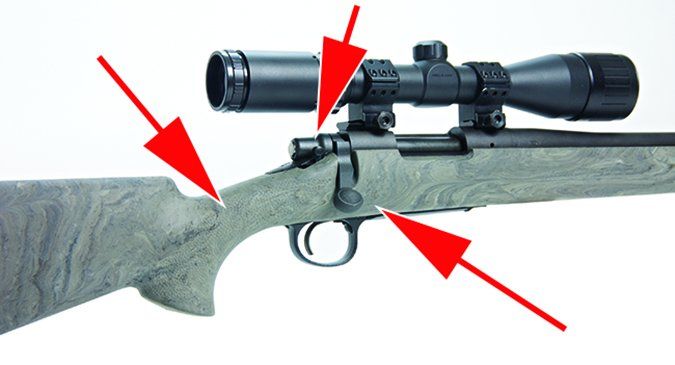
Before we get into the rifle specifics, it’s worth a few words to talk about the cartridge. The 300 AAC Blackout (300 BLK) is a 30-caliber projectile sized to fit into a 5.56mm-sized AR-pattern rifle, like the 300 Whisper before it. The 300 Whisper was developed and trademarked in 1992 by J.D. Jones. Advanced Armament Corporation (AAC) developed the Blackout round reportedly for a U.S. military special missions unit that wanted a 30-caliber cartridge that could be easily adapted to AR-15 magazines and bolts and which could be developed in both subsonic (for suppressed use) as well as supersonic loads. The cartridge has dimensions of 7.62x35mm and keeps the 5.56x45mm cartridge’s rim dimensions and tapered shape, meaning the 300 BLK could function with a standard 5.56 NATO bolt and standard 5.56 magazine. As a result of shoving a 30-caliber bullet into a suitable case, the 300 BLK has a shallow neck relative to the case. The 300 BLK has plenty of reloading components (cases, bullets, dies) available for its development, and quite a few ammunition companies now make it commercially. A quick check at MidwayUSA.com finds 61 commercial loads available in 300 BLK, in bullet weights from 88 grains to 240 grains. As an aside, Remington purchased AAC in 2009.
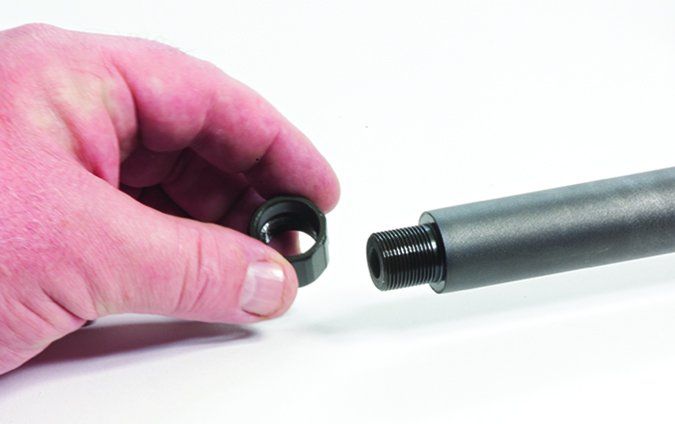
The SPS-T looks odd, we have to say, because it has a stubby 16.5-inch heavy-contour barrel. After a moment’s thought, it makes sense that all three barrels would have thickish contours (0.883 inch at the muzzle for the SPS-T) to have enough material to hold the threads and a can. That puts the Remington’s out-of-the-box weight at 8.25 pounds, the heaviest of the test, but its short barrel makes the OAL just 36.25 inches, a quarter-inch longer than the Ranch rifle and 2 inches shorter than the Savage. A nine-sided steel thread protector comes installed, and it easily screws on and off with finger pressure. The rifling rate is marked midway down on the right side of the barrel as “5-R Tactical 1:7 Twist,” which should have been enough spin to stabilize the 220-grain Remington load, but which didn’t, at least unsuppressed. The unsuppressed 6.0-inch average group size was shockingly bad, especially when compared to the suppressed 0.6-inch average group size with the same round. The SPS-T shone with the Sellier & Bellot 147-grain FMJs, shooting 1.0-inch groups unsuppressed and 0.4-inch average group size suppressed in the Remington.
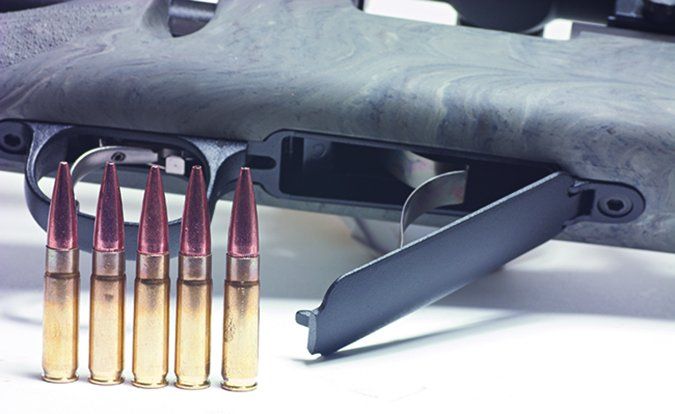
It gets this accuracy with fundamental gun building. The barreled action is set into a Hogue OverMolded Ghillie Green pillar-bedded, synthetic stock with a semi-beavertail fore-end. It looked more grey than green to us, and we found it very well mannered on the shooting bench. It featured one sling-swivel stud on the butt and one on the forend. The dual-point pillar bedding produces a stable relationship between the action and stock, and as a result, we didn’t see stringing when we fired up to five rounds at a time, and the first-shot cold-barrel zero was good for following rounds, showing no point-of-impact shifts. On the bench, the pebbled grip on the stock was comfortable and positive. The 5-R rifling on the SPS-T is the same type as found on the company’s M24 SWS (Sniper Weapon System) rifle barrel. There are five lands instead of six, as on a traditional barrel. Also, traditional lands are squared off at a 90-degree angle to the groove, while the lands on 5-R rifling are tapered at 110 degrees, which results in less bullet deformation, according to Remington. Also, none of the lands are directly across from one another. The barrel free-floated in the stock channel. Remington touts these features as leading to better accuracy and less fouling, and based on our results, we have to agree in most cases. Add Remington’s X-Mark Pro externally adjustable trigger, which we adjusted down to 2.5 pounds with the included Allen wrench, and you have the major components for accuracy.
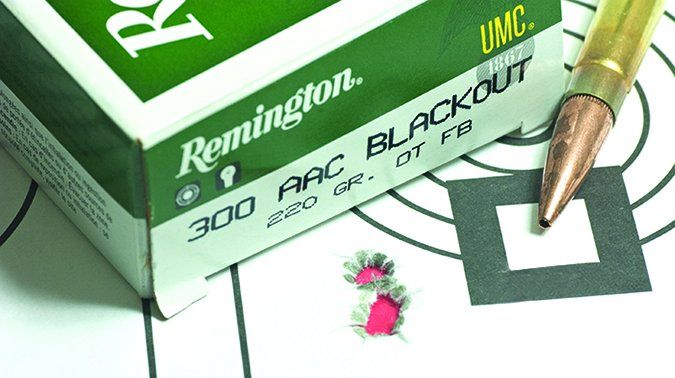
Installing Weaver bases on the drilled-and-tapped receiver was easy, but Savage has the better idea of providing an installed 1913 rail with the rifle, in our opinion. Five rounds fed cleanly out of the hinged steel floorplate internal magazine, and we didn’t experience any binding issues as we did on the Savage. Unloading the magazine took the push of a button, located inside the front of the trigger guard. The stock doesn’t have much drop at the comb or at the heel, and there’s not much pitch either. The gun comes up to the face mid-cheek for most shooters. The rifle’s soft Supercell recoil pad reduced what little push the 300 BLK makes, which is even less with the silencer on.
We liked the trigger, the adjustment screw for which can be reached with the short end of the wrench, rather than poking it through a hole in the trigger guard. Remington thoroughly warns shooters not to adjust the trigger pull force below 3 pounds unless it’s being fired from a secure stationary rest in a controlled environment, which it was. So to move the trigger pull to 2.5 pounds with an empty chamber and magazine, we placed the provided wrench’s hex key in the socket of the adjustment screw located at the top of the trigger. A standard 1⁄16-inch hex key can also be used to make this adjustment. Turning the trigger-pull-adjustment screw counterclockwise lightens the trigger-pull force. Turning the trigger-pull-adjusting screw clockwise increased the trigger pull force by approximately 1 pound for each full turn of the adjustment screw. After making an adjustment, we used an empty casing to dry-fire the rifle several times to ensure the trigger-pull force spring was re-seated. It is unusual for us to like a factory trigger, but this one was all right. We preferred the flat face of the Remington trigger to the blade in the Savage’s trigger face.
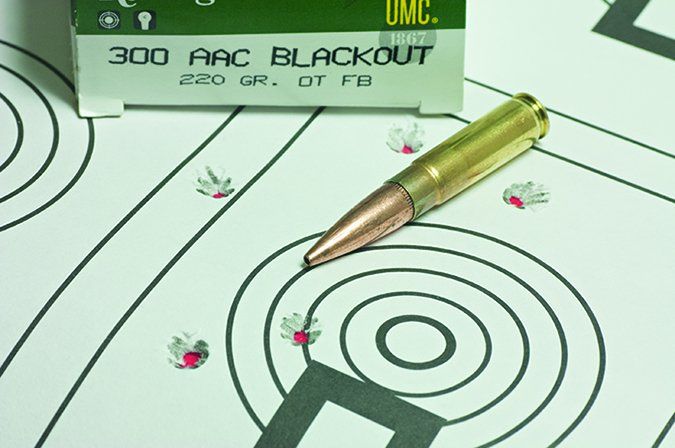
To engage the thumb safety on the right rear of the action, pull the safety lever fully to the rear towards the ‘S’ position, for Safe. When you are ready to shoot, push the safety mechanism forward towards the ‘F’ position to disengage the safety mechanism, making it ready to Fire. We experienced no failures with the operation of the safety.
Installing the bolt assembly is simple. With the safety mechanism in the ‘S’ position and with an empty rifle, align the lugs on the bolt assembly with the receiver, then slide the bolt assembly into the receiver and push it all the way in. Removing the bolt is easy on the SPS-T, on par with the Ruger. Raise the bolt handle, pull the bolt handle all the way back, push the bolt stop release in the top of the trigger guard, and slide the bolt assembly out of the firearm.
Our Team Said: The Remington SPS-T is a fine-shooting firearm in 300 BLK. If you already have an AR-15 lower with a 300 BLK upper on it, this is a great way to add a bolt-rifle support to shoot subsonics suppressed. However, we’d think real hard if we already had an AR-10 about staying with the 308 Win. in the Savage instead of adding another cartridge to our collection, or getting this same SPS-T in 308 Win. (No. 85538). The latter rifle earned a B+ grade in the October 2017 issue, so we think it stands on par with the 10PT-SR.
Ruger American Rifle Ranch 06968 300 Blackout, $420
GUN TESTS GRADE: A-
This Ranch Rifle is a good, lightweight solution for coyotes or deer, and it shot well both suppressed and unsuppressed. Its short length would make it handy getting in and out of a pickup, even with a big can on it.

| ACTION | Bolt; machined-steel hexagonal receiver |
| OVERALL LENGTH | 36 in. |
| HEIGHT UNBOXED | 6.75 in. |
| HEIGHT AS TESTED | 9 in. |
| MAX WIDTH | 2.6 in. |
| WEIGHT UNBOXED | 6.2 lbs. |
| WEIGHT RANGE | 7.5 lbs. |
| BARREL LENGTH/TWIST | 16.12 in.; 1:7 RH; 6 grooves |
| BARREL FINISH/MATERIAL | Matte-blue carbon steel; cold hammer forged |
| BARREL FLOATED | No |
| BARREL MUZZLE DIAMETER | 0.748 in. |
| BARREL MUZZLE STYLE/DEVICE | 5/8″ -24 thread; 2-side steel thread protector |
| STOCK | Power Bedding integral block; Flat Dark Earth synthetic; grooved pistol grip texture |
| STOCK LENGTH OF PULL | 14 in. |
| STOCK COMB STYLE | Straight |
| STOCK DROP AT COMB | 1.6 in. |
| STOCK DROP AT HEEL | 1.75 in. |
| STOCK PITCH | 2.75 in. |
| STOCK CAST | None |
| STOCK HANDEDNESS | Ambidextrous |
| STOCK FOREND STYLE | Sporter; grooved |
| STOCK BUTTPAD THICKNESS | 1 in. |
| STOCK SLING SWIVEL ATTACHMENTS | 1 butt, 1 forend |
| STOCK GRIP CAP | Black plastic; Ruger logo |
| TRIGGER PULL WEIGHT | 3.2 lbs.; Marksman adjustable |
| TRIGGER STYLE | Single stage |
| TRIGGER GUARD MATERIAL | FDE polymer |
| SAFETY | 2-position tang-mounted slider button |
| MAGAZINE | (1) 5-rd. detachable box; rotary flush-fit black polymer |
| MAGAZINE RELEASE | Polymer tab; front of magazine |
| BOLT | 3 lug; stainless steel; plunger ejector; 70-degree throw; blued ball handle |
| BOLT RELEASE | Action-mounted lever; left rear receiver |
| SIGHTS | None |
| OPTICS MOUNTING HARDWARE | 1-piece aluminum rail installed |
| WARRANTY | None written |
| TELEPHONE | (336) 949-5200 |
| WEBSITE | Ruger.com |
| MADE IN | Mayodan, NC |
This was the counter price at an Academy store in Houston. MSRP is $529. The Ruger Ranch Rifle comes in several chamberings, including our test gun with a five-round rotary magazine, the new 26968 in 300 BLK with an AR-style magazine, the 06965 in 5.56 NATO/223 Rem., the 16950 in 450 Bushmaster with a single-stack magazine, the 16976 in 7.62×39 with a Mini Thirty magazine, the 26965 in 5.56 NATO with an AR-style magazine, and the 16978 in 450 Bushmaster and a camo stock. If you’re interested in the cartridge more than the rifle, Ruger also chambers an upper for the SR-556 Takedown (90455) in 300 BLK, as well as the Mini-14 Tactical Rifle 05864.
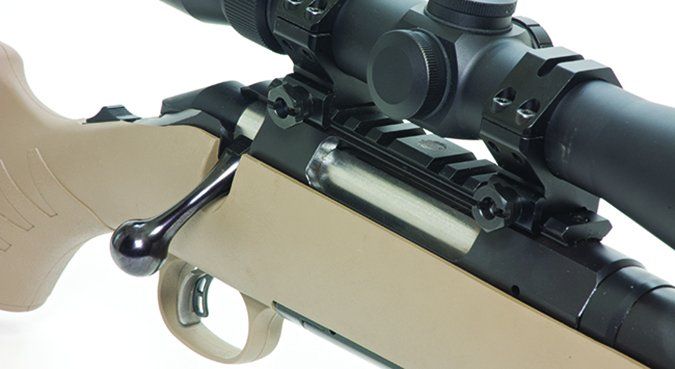
The Ranch Rifles come stocked with Flat Dark Earth synthetic units paired with a 16.12-inch-long alloy steel barrel with a muzzle diameter of 0.748 inch and the muzzle threading of 5⁄8×24. As noted above, it comes with a 5-inch-long short-action aluminum scope rail installed, but the rail doesn’t have all 1913 slots — so a one-piece Picatinny base won’t fit. The matte-black anodized rail displays the Ruger Eagle logo and is mounted to the receiver with four Torx screws.
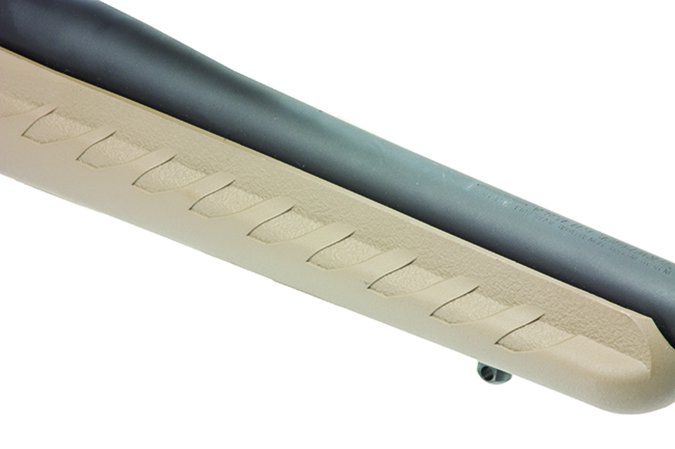
Like the Remington, the Ranch has a 1:7-inch right-hand twist, but with traditional six grooves/lands, which didn’t seem to hurt it one bit. The rifle’s hammer-forged barrel is mated to the steel action with a barrel-nut system that ensures perfect headspace. This barreled action sits on a pair of V-notch supports that bed the action. The RR held five rounds in the rotary black-polymer magazine, which snapped smoothly into the stock, unlike the Savage magazine.
But it is the physical dimensions, as well as its accuracy, that makes the Ranch interesting. This rifle is simply much smaller than the others. Out of the box, it weighed only 6.2 pounds (0.3 pounds more than the manufacturer’s specs, however). Loaded out for the range, the Ranch weighed 2 pounds less than the Savage and 2.6 pounds less than the SPS-T. Overall length was a handy 36 inches, with a longish 14-inch length of pull and a straight comb with a middling amount of drop. After handling and testing the Ranch, our shooters said that in and around a vehicle, even with a 9-inch suppressor, aboard, the rifle was easy to move from the driver’s seat out the window.
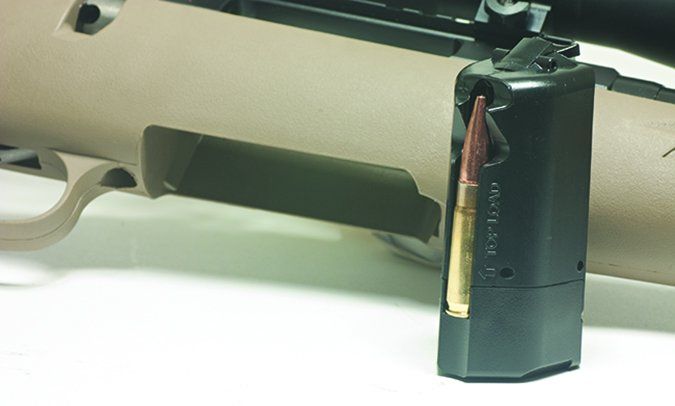
Like on the others, we couldn’t see any cast in the stock, and both left- and right-handed shooters could shoulder the rifle comfortably and work the bolt, though lefties would have to reach over the rifle to operate the bolt, of course. The stock was a sporter shape, rather than the flattened beavertail fronts on the others, which made it roll around on the bags a little more. The stock had two sling-swivel studs, one in the butt and one in the forend. The buttpad was a cushy 1-inch-thick model that was very comfortable on the shoulder. The pistol grip had a grooved texture molded into it. Underneath the action was the company’s patent-pending Power Bedding feature, an integral bedding block system that holds the receiver. It was also supposed to free-float the barrel, but ours didn’t. As noted above, it didn’t seem to affect accuracy. Unsuppressed, the Ruger shot on par with the heavier Remington when fed the 120-grain UMCs and the 147-grain S&Bs, and it way outshot the SPS-T with the 220-grain subsonics. Suppressed, the SPS-T was a little better overall, but the Ruger still shot two rounds under MOA.
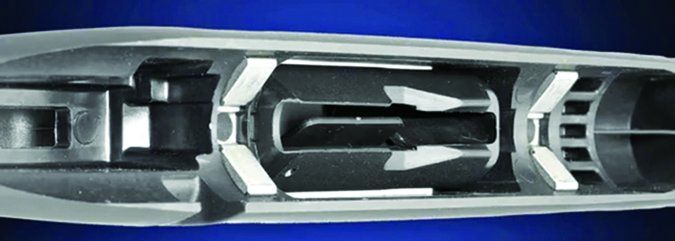
The Ruger was easier to run because its three-lug bolt required only 70 degrees of throw compared to 90 degrees on the other rifles. That left ample scope clearance. The full-diameter bolt body and dual cocking cams offered smooth, easy cycling from the shoulder — better than the others, our shooters said. But we liked the big bolt handle on the Savage better. The five-shot magazine loaded easily, and the cartridges mostly fed smoothly. Only one rotary magazine came with the rifle. It’s an all-polymer piece that fits flush with the bottom of the stock, reducing the chance of it hanging on clothing or car parts. We had a couple of rounds pop out of the magazine and wedge in the left side of the receiver. Also, the slab-sided receiver on the Ranch was cut higher on the left side than the other rifles, so it was harder to see into the magwell to check out if a round had gone astray. All ammunition tested functioned perfectly.
Removing the bolt was simple: Press a lever on the left rear side of the action and pull the bolt out. It didn’t require two fingers like the Savage, and the lever is easier to see than the Remington’s tab up inside the trigger guard.
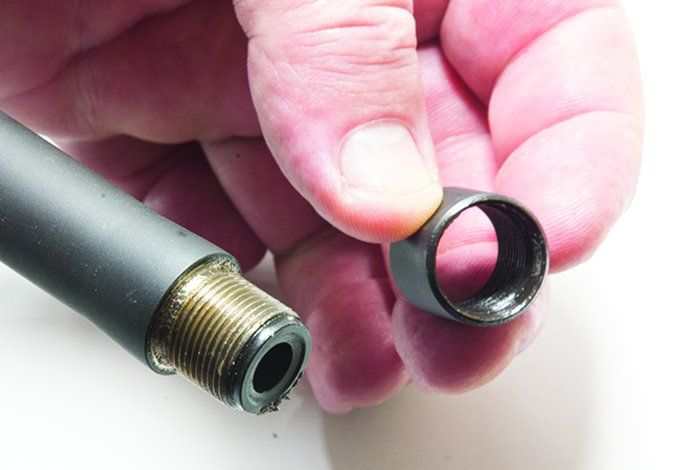
The Ruger has a two-position tang safety. The safety selector is located behind the bolt sleeve. The safety selector can be moved from the Fire position to the Safe position only when the firing pin is cocked. Fully raising the bolt handle cocks the firing pin. The cocking piece will protrude from the bolt shroud when the firing pin is cocked. We liked this safety better than the Savage’s and as well as the Remington’s lever. It was visible, accessible, and easy to operate.
Ruger Marksman Adjustable trigger offers a crisp release with a pull weight that is user adjustable between 3 and 5 pounds. To access the pull-weight set screw, remove the barreled action from the stock. The set screw is located on the outside, forward edge of the fire control housing and is treated with a thread-locking compound, so it was difficult to move. Turning the screw in (clockwise) will increase the trigger pull weight; threading the screw out (counter-clockwise) will reduce the trigger pull weight. There is about six full turns of adjustment. Turning the screw in no more than half-revolution increments, we got the trigger-pull weight down to 3 pounds.
Our Team Said: If you’re looking for a lightweight suppressed solution for coyotes or deer, this Ranch Rifle is an easy winner. There is a caveat with the Surge suppressor in place, however; the can really throws off the balance of an otherwise handy rifle. Also, the price was right, so it’s hard to find much fault with Ruger’s American Ranch Rifle in 300 BLK.
Written and photographed by Gun Tests staff, using evaluations from Gun Tests team testers.



























